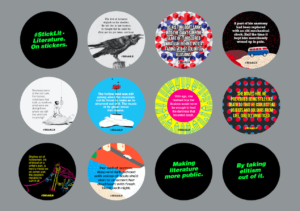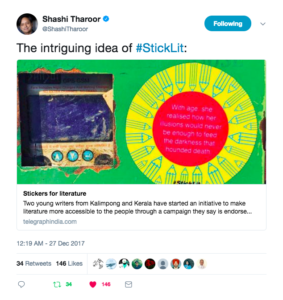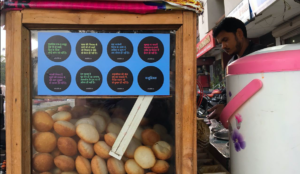An interview with Manoj Pandey, curator of “StickLit”
 Manoj Pandey, curator of #StickLit, Literature on Stickers, believes that literature needs to be made more public and the elitism needs to be removed from it. Hence he co-founded the movement #StickLit. There are stickers being posted worldwide on streets and in multiple languages.
Manoj Pandey, curator of #StickLit, Literature on Stickers, believes that literature needs to be made more public and the elitism needs to be removed from it. Hence he co-founded the movement #StickLit. There are stickers being posted worldwide on streets and in multiple languages.
Here are excerpts from an email interview with Manoj Pandey:
How did #StickLit come about?
In the same manner #MeToo did. It just surfaced. Because enough was enough. In this case it was the abuse of talent and passion. By institutions of art and literature.
Do you find that with the digital tools, literature has become accessible to many more people but at the same time, ironically elitist?
Yes, because digital has no reach or impact. 
Who are the writers contributing snippets on the stickers? Are these new writers or established writers?
They have chosen to remain anonymous. It could be anyone, from household names to rising stars to nobody. They’re just people who’re thrilled by radical ideas such as Aristotle being read by a rickshaw puller. They feel that even this dialogue between two disparate minds, Aristotle and the rickshaw puller, deserves a chance. They feel that even a rickshaw puller deserves more than just a marginal experience. He too deserves once in a day to entertain a phrase such as: ‘To be or not to be.’ He too deserves the luxury of thought.
 Who is selecting, rather curating, the information on the stickers?
Who is selecting, rather curating, the information on the stickers?
We initiated it. But now the network and the movement has its own independent bases. Which no one has control over. The power is in the hands of the writers and the artists who feel for the cause and are doing their bit.
Who can print and paste the stickers? As the co-founder of the movement do you keep an eye on all the material using your platform or is it democratic in its use allowing anyone and everyone to use it? ( In this article on #JLF read what Sanjoy Roy has to say about making literature accessible to everyone. Sanjoy Roy’s favourite memory was the most heart-warming of them all; he narrated the story of how once an underprivileged man walking with his child was stopped by the security guard, because he “didn’t look like he belonged”. )
Like I said we initiated it. But now we have no control over it. And we don’t want to also. We wanted to question the institutions on why they’ve turned this dialogue between a writer and a reader merely into a function of money. We wanted to shake things a little before a book, too, turned into a bottle of cola. Or a candy. We wanted to bring back joy in the simple act of writing. That’s all.
Will these stickers be available in all languages or only Hindi and English to begin with?
It’ll be available in as many regional languages as possible. 
Why are the authors not identified on the stickers? Does it not defeat the purpose of making literature available to everyone? Or is this a design restriction of being unable to accommodate the writer and translator?
Purpose comes before the person. This whole system of credit, brand name, following, etc., were created by marketers. Note: this is not a promotional platform for authors to sell their work.
2 January 2018
